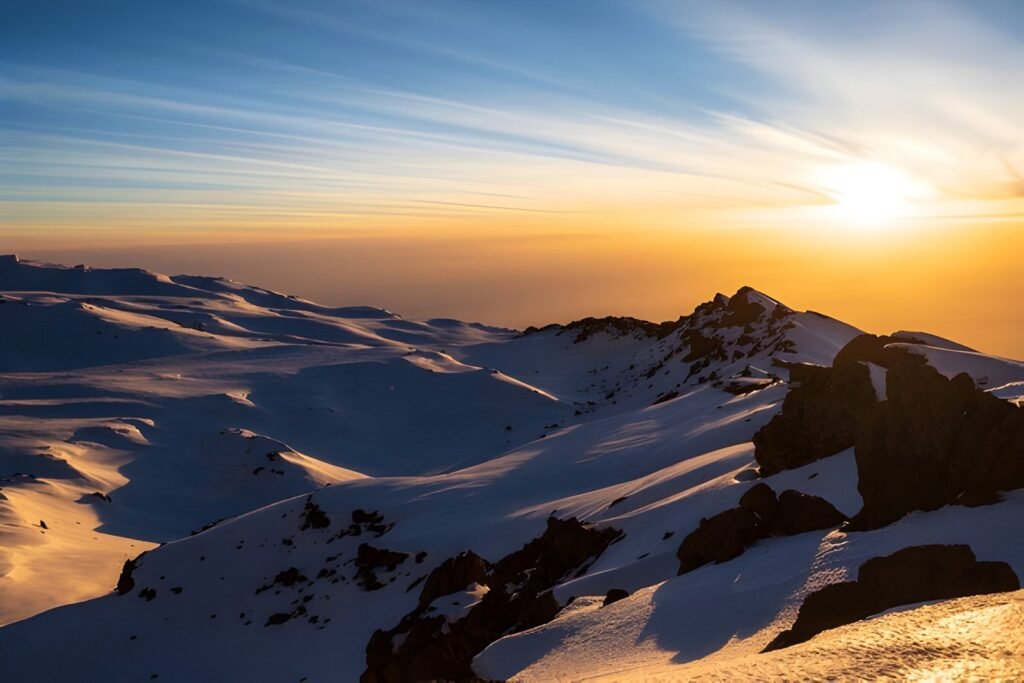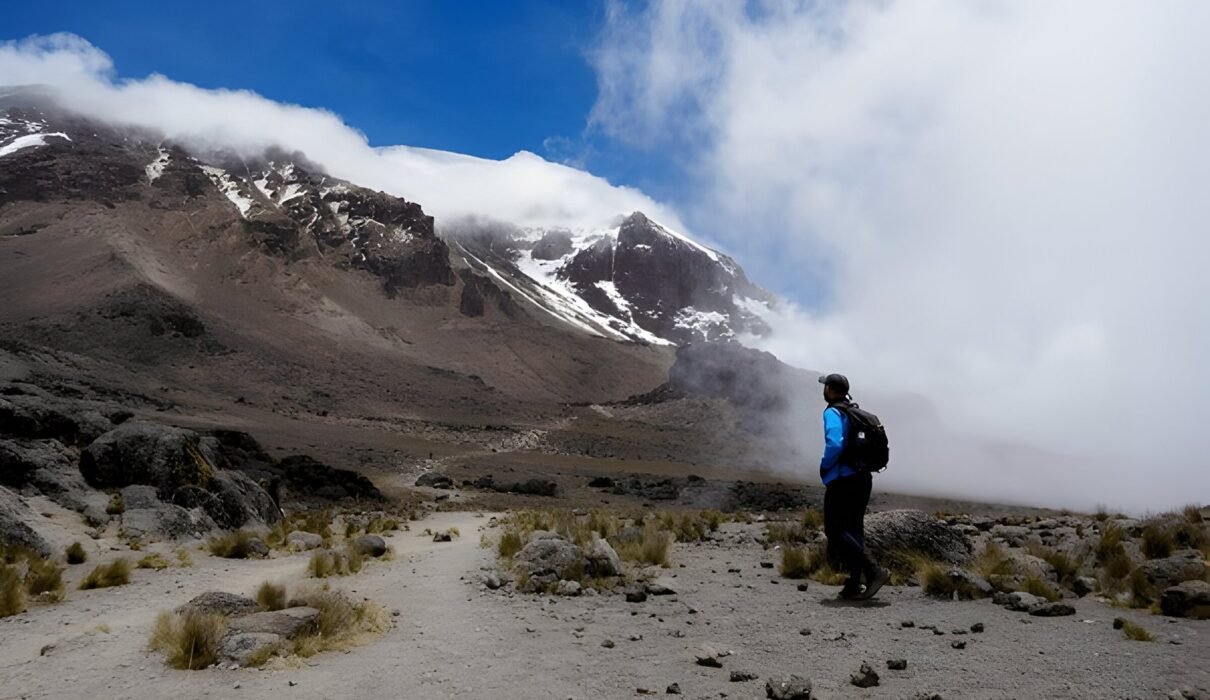Why Does Mount Kilimanjaro Have Snow, Glaciers, and an Ice Cap ? Mount Kilimanjaro, Africa’s tallest mountain, rises majestically above the plains of Tanzania. Despite being located just 200 miles south of the equator, Kilimanjaro’s summit is capped with snow, glaciers, and ice year-round. For many, this phenomenon seems puzzling given the mountain’s location in the tropics. In this guide, we’ll explore why Mount Kilimanjaro maintains snow and glaciers and the factors that influence its icy crown.

Why Does Mount Kilimanjaro Have Snow, Glaciers, and an Ice Cap ? – Altitude: The Key Factor for Kilimanjaro’s Snow and Ice
The most important reason Kilimanjaro has snow and glaciers is its altitude. The peak of Kilimanjaro, known as Uhuru Peak, stands at 5,895 meters (19,341 feet) above sea level. As you ascend, temperatures drop rapidly, even in tropical regions like Tanzania.
- Temperature Drops: For every 1,000 meters of elevation gained, the temperature decreases by about 6.5°C (11.7°F). At Kilimanjaro’s summit, temperatures can plummet to -20°C (-4°F) or lower, making it cold enough for snow and ice to form.
This dramatic drop in temperature explains how snow and glaciers can persist on the mountain despite its proximity to the equator.
Learn more about Kilimanjaro’s elevation with Kilimanjaro Climb Specialist
Why Does Mount Kilimanjaro Have Snow, Glaciers, and an Ice Cap ? – Kilimanjaro’s Glaciers: A Legacy of the Ice Age
Kilimanjaro’s glaciers are remnants of the last Ice Age, which occurred approximately 11,000 years ago. During this period, the Earth experienced much colder temperatures, and glaciers formed at higher altitudes around the world, including on Kilimanjaro. These glaciers have remained largely intact, although they are now retreating due to climate change.
- Furtwängler Glacier: The largest glacier near Kilimanjaro’s summit is the Furtwängler Glacier, which is a key feature of the mountain’s icy cap.
The glaciers, though shrinking, continue to persist at the summit, offering a glimpse into Earth’s glacial past.
Read more about Kilimanjaro’s glaciers at GlacierHub
Why Does Mount Kilimanjaro Have Snow, Glaciers, and an Ice Cap ? – Why Does Snow Fall on Kilimanjaro?
Snowfall on Kilimanjaro is another intriguing aspect. The combination of high altitude and Tanzania’s tropical weather patterns leads to the formation of snow at the peak. Kilimanjaro experiences two distinct rainy seasons: the long rains from March to May and the short rains in November. During these times, moisture-laden winds from the Indian Ocean bring precipitation to the mountain.
- Snowfall: At higher altitudes, this precipitation falls as snow, which accumulates on the glaciers and ice cap.
Even though Kilimanjaro is located in the tropics, its elevation causes any moisture reaching the summit to freeze, creating the permanent snowfields that are iconic of the mountain.
Learn about Tanzania’s weather patterns with Eddy Tours Safaris
Why Does Mount Kilimanjaro Have Snow, Glaciers, and an Ice Cap ? – The Ice Cap: Kilimanjaro’s Shrinking Glacier Crown
Kilimanjaro’s ice cap has been a defining feature of the mountain for thousands of years, but in recent decades, it has been shrinking at an alarming rate. Studies show that the ice cap on Kilimanjaro has lost more than 80% of its mass since 1912. Scientists attribute this to climate change and global warming, which have led to rising temperatures and reduced snowfall at the summit
- Impact of Climate Change: As temperatures rise and snowfall decreases, the ice cap is expected to disappear entirely within the next few decades if current trends continue.
This rapid retreat is a clear indicator of global climate change and its effects on high-altitude ecosystems, even in tropical regions like Tanzania.
Explore the effects of climate change on Kilimanjaro’s glaciers
Why Does Mount Kilimanjaro Have Snow, Glaciers, and an Ice Cap ? – Kilimanjaro’s Unique Microclimates
One of the fascinating aspects of Kilimanjaro is the variety of microclimates found on its slopes. As you ascend the mountain, you pass through several distinct ecological zones, each with its own climate and vegetation.
- Rainforest Zone (1,800 – 2,800 meters): The base of Kilimanjaro is surrounded by lush rainforest, where temperatures are warm, and rainfall is abundant.
- Moorland Zone (2,800 – 4,000 meters): This zone features low-growing shrubs and grasses, with cooler temperatures and less rainfall.
- Alpine Desert (4,000 – 5,000 meters): Here, the landscape is barren, with little vegetation and freezing temperatures at night.
- Summit Zone (Above 5,000 meters): The summit of Kilimanjaro is covered in snow, glaciers, and an ice cap, where temperatures remain below freezing, and the air is thin.
The transition through these microclimates is one of the unique aspects of climbing Kilimanjaro and is a key factor in why snow and glaciers can persist at the summit.
Learn about Kilimanjaro’s climate zones
Why Does Mount Kilimanjaro Have Snow, Glaciers, and an Ice Cap ? – What Does the Future Hold for Kilimanjaro’s Snow and Glaciers?
The future of Kilimanjaro’s snow and glaciers is uncertain. While the mountain’s high altitude ensures that snow will continue to fall at the summit for the foreseeable future, the glaciers and ice cap are rapidly shrinking. If current trends continue, experts predict that Kilimanjaro may lose its glaciers entirely by 2040 to 2060.
- Ongoing Research: Scientists are continuing to study the effects of climate change on Kilimanjaro’s glaciers to better understand the impact of global warming on high-altitude environments.
The disappearance of Kilimanjaro’s glaciers would not only affect the mountain’s iconic appearance but also have implications for local ecosystems and water sources.
Read more about Kilimanjaro’s changing glaciers
Cultural Significance of Kilimanjaro’s Ice Cap
Kilimanjaro’s snow-capped peak holds deep cultural and spiritual significance for the local communities in Tanzania. The Chagga people, who live on the slopes of the mountain, believe Kilimanjaro’s glaciers are a source of water and fertility for the land below. The melting of the ice cap has raised concerns among local communities about the future of water supplies and agriculture.
- Local Legends: In Chagga folklore, the mountain’s snow is believed to be a gift from the gods, and its gradual disappearance is seen as a sign of changing times.
As the glaciers retreat, it not only alters the natural landscape but also impacts the cultural heritage of the region.
Learn about the Chagga people and Kilimanjaro’s cultural significance
Why Does Mount Kilimanjaro Have Snow, Glaciers, and an Ice Cap ? : FAQs
1. Why does Kilimanjaro have snow despite being near the equator?
Kilimanjaro’s high altitude causes temperatures to drop significantly at the summit, allowing snow and ice to form even though the mountain is near the equator.
2. Are Kilimanjaro’s glaciers melting?
Yes, Kilimanjaro’s glaciers have been shrinking rapidly over the past century due to climate change and global warming. Scientists predict they could disappear within a few decades.
3. What is the best time to see Kilimanjaro’s snow and glaciers?
The best time to see Kilimanjaro’s snow-covered peak is during the dry seasons, from June to October and December to March, when the weather is clear.
Plan your Kilimanjaro trek to see its glaciers with Kilimanjaro Climb Specialist

Why Does Mount Kilimanjaro Have Snow, Glaciers, and an Ice Cap ? : Conclusion
Mount Kilimanjaro’s snow, glaciers, and ice cap are extraordinary features that stand in stark contrast to the tropical landscape below. The combination of high altitude, historical glaciers, and ongoing snowfall makes Kilimanjaro one of the most unique and fascinating mountains in the world. However, the rapid retreat of its glaciers due to climate change highlights the urgent need for global environmental action to preserve these natural wonders.
Start planning your Kilimanjaro climb to witness its glaciers with Kilimanjaro Climb Specialist
Book your Kilimanjaro adventure with Eddy Tours Safaris

